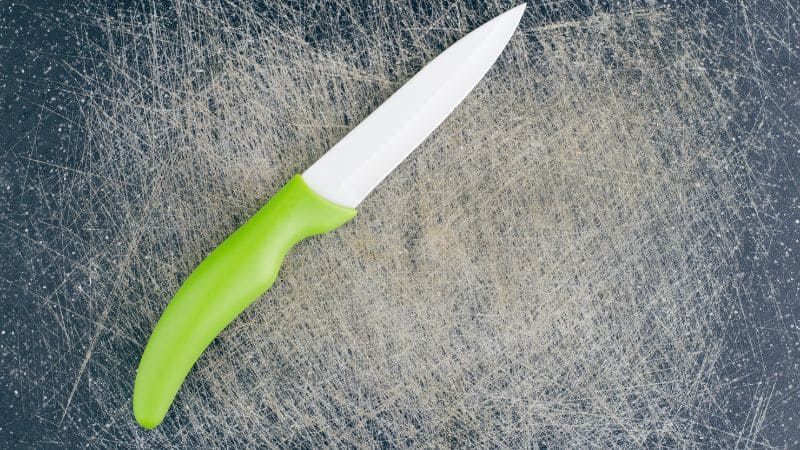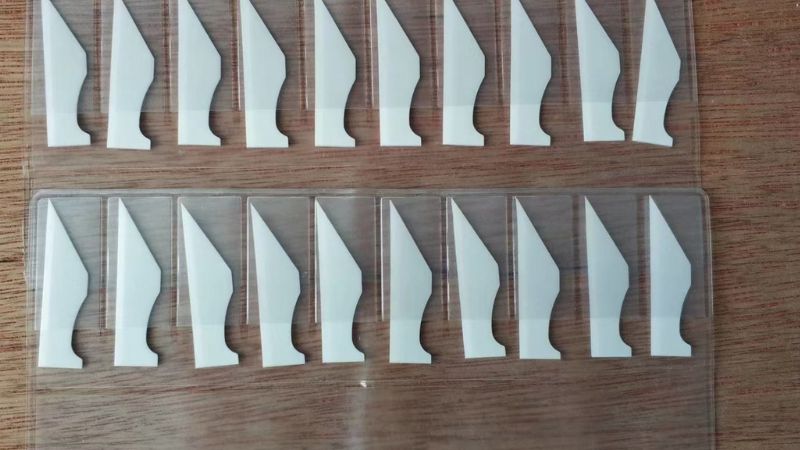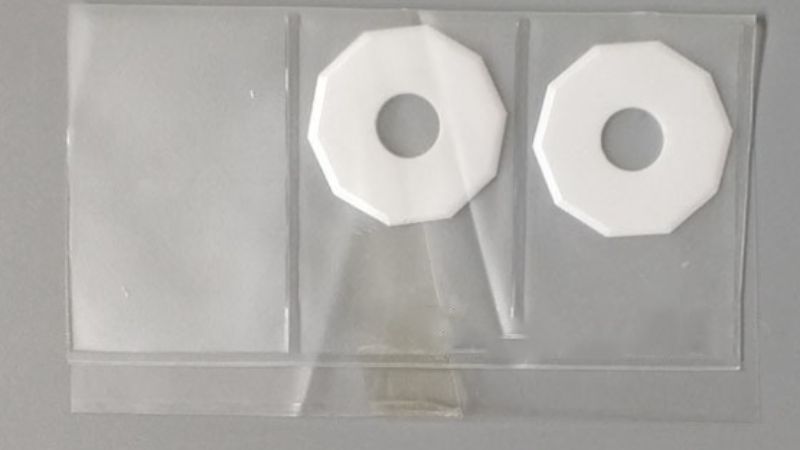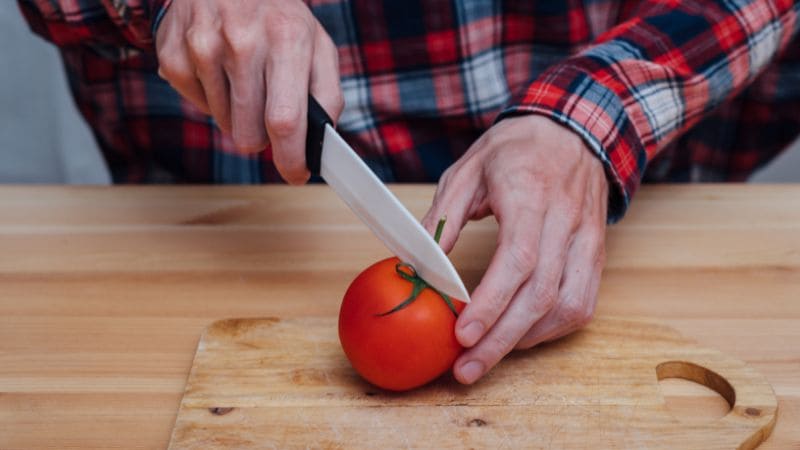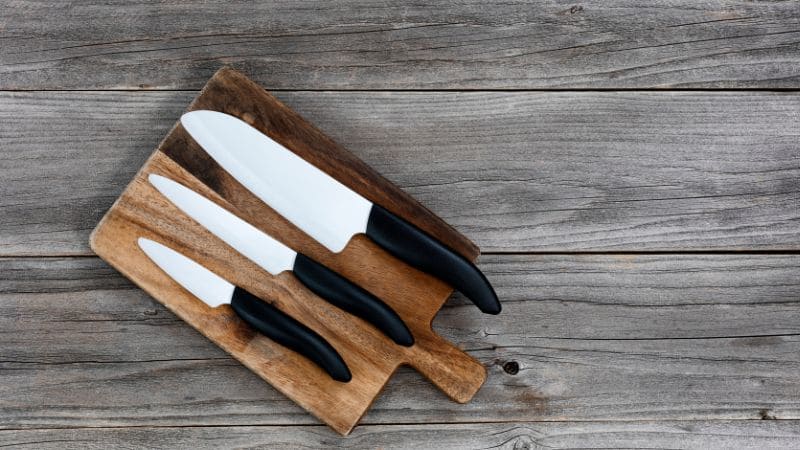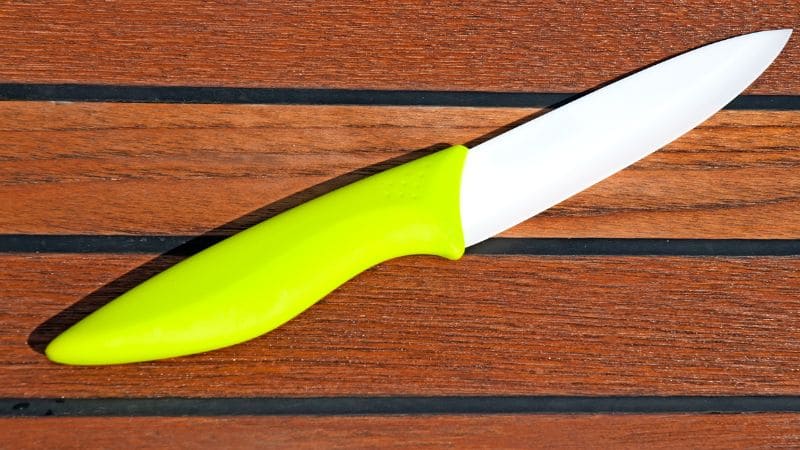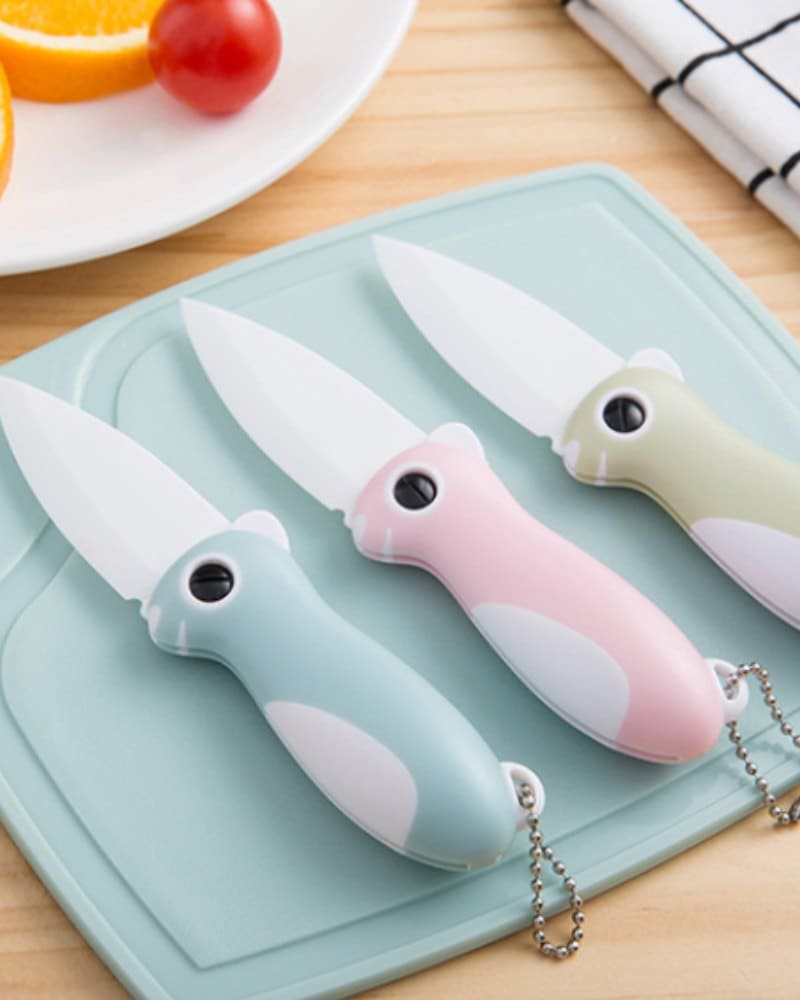Table of Contents
You ever have that one knife you thought would last forever, but after a few months, it starts struggling to cut a tomato? Yeah, me too. I remember slicing into a ripe mango last summer with my trusty steel knife – or so I thought – and ending up with more pulp than slices. Frustrating, right? That’s when I started digging into alternatives, and ceramic blades kept popping up.
Here’s the quick answer – ceramic blades are incredibly sharp, lightweight, and they won’t rust. But, they chip easily and aren’t your best friend if you’re planning to chop through bones or frozen foods.
So, are ceramic blades worth it? Well, that depends on how you plan to use them. In this post, I’m going to break down the pros and cons of ceramic blades from my own experience – the good, the bad, and the unexpected. Stick around, because if you’ve ever wondered if ceramic is worth the hype, I’ve got you covered.
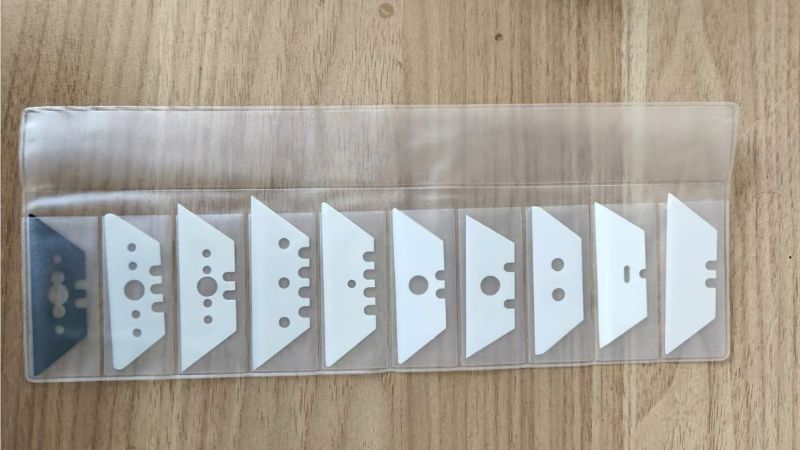
Understanding Ceramic Blades
I remember the first time I held a ceramic blade – it felt like holding something out of a sci-fi movie. Light as a feather but sharp enough to glide through a ripe tomato without the usual squish. I was skeptical at first. I mean, how could something that feels so delicate outperform my trusty steel knives? But once I got the hang of it, I realized ceramic blades were in a league of their own.
What Makes Ceramic Blades Unique?
Ceramic blades are crafted from zirconium oxide, a material that’s sintered at extremely high temperatures to create an exceptionally hard edge – almost as hard as diamonds. This hardness is why ceramic blades can stay sharp up to 10 times longer than steel blades.
But here’s the trade-off – while they’re incredibly sharp, they’re also brittle. Drop one on a hard floor, and you might just end up with ceramic confetti. That said, for slicing fruits, vegetables, and boneless meats, they’re unbeatable.
Key Characteristics of Ceramic Blades:
- Hardness – Second only to diamonds on the Mohs hardness scale.
- Non-Porous – Won’t absorb food particles, juices, or odors.
- Lightweight – Easier on the hands during repetitive tasks.
- Corrosion-Free – They simply don’t rust, no matter how wet they get.
Types of Ceramic Blades
Not all ceramic blades are created equal. I found this out the hard way when I bought a bargain-brand ceramic knife online. Let’s just say it didn’t make it past its third avocado pit. Investing in quality makes all the difference.
Here are the most common types:
| Type of Blade | Best For | Durability |
|---|---|---|
| Utility Knife Blade | Daily Use | High |
| Paring Knife Blade | Cutting fruits, peeling | High |
| Chef’s Knife Blade | Chopping, dicing vegetables | Moderate – Avoid hard foods |
| Single Razor Blades | Industrial, household use | High |
| Ceramic Scissors Blades | Industrial, textile cutting | High |
Pro Tip: Brands like JCK lead the market in durable, high-quality ceramic knives. If you’re serious about making the switch, start there.
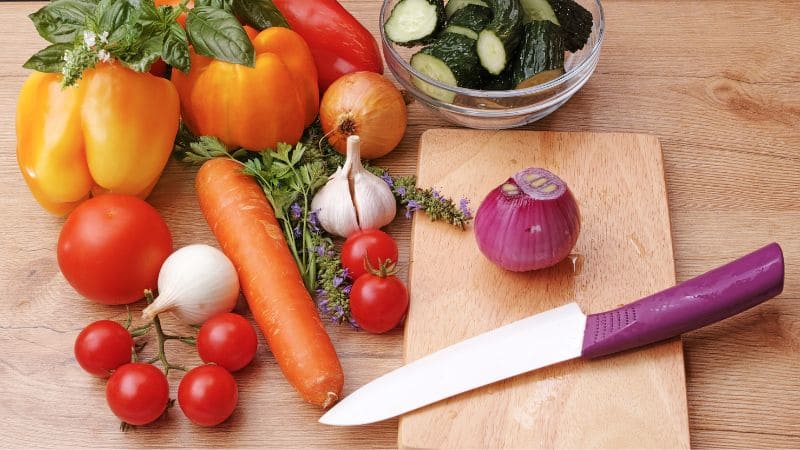
How Ceramic Blades Differ from Steel Blades
Let’s break it down. I love steel knives – they’re durable, flexible, and can handle just about anything. But they rust. And they need sharpening. A lot.
Ceramic blades, on the other hand, require very little upkeep. But they have their limits. They can’t cut through bone, and prying open a jar lid? Forget about it.
| Feature | Ceramic Blades | Steel Blades |
|---|---|---|
| Sharpness Retention | Stays sharp 10x longer | Dulls faster, requires frequent honing |
| Rust Resistance | 100% – No rust | Prone to rust without oiling |
| Weight | Extremely lightweight | Heavier |
| Durability | Brittle, prone to chipping | Flexible and tough |
| Best Use | Soft foods, fruits, boneless meats | Hard foods, bones, frozen items |
Steel blades are workhorses. Ceramic blades? Precision instruments. Each has its place, but knowing when and how to use them makes all the difference.
Pros of Ceramic Blades
Ceramic blades stand out for their durability and cutting precision. They stay sharp, resist rust, and are incredibly lightweight – making them an excellent choice for many kitchen tasks.
Exceptional Sharpness and Edge Retention
Ceramic blades can maintain their sharpness up to 10 times longer than steel blades. Because zirconium oxide is incredibly hard, it resists dulling even after frequent use. This makes them perfect for precision cutting and fine slicing.
Real-Life Example: I’ve had my JCK ceramic paring knife for over a year, and it’s still as sharp as the day I bought it – even after weekly use.
Why It Matters:
- Less sharpening required.
- Consistent, clean cuts for longer periods.
- Ideal for repetitive slicing tasks in professional kitchens.
Corrosion and Rust Resistance
One of the most appealing aspects of ceramic blades is that they are completely immune to rust and corrosion. Unlike steel blades that can rust if left wet, ceramic blades can be rinsed and left to air dry without any worry.
I can’t count how many times I’ve left a steel knife soaking in the sink, only to find ugly rust spots the next morning. With ceramic knives, that’s just not an issue. I’ll wash them, leave them out, and they look brand new every time.
Benefits at a Glance:
- Zero rust, even in high-humidity kitchens.
- No need for oiling or drying after each wash.
- Perfect for cutting acidic foods like lemons and tomatoes without staining.
| Blade Material | Rust Resistance | Maintenance Required |
|---|---|---|
| Ceramic | 100% Rust-Proof | Low – Simple washing |
| Stainless Steel | Prone to Rust | High – Requires oiling |
| Carbon Steel | Highly Prone | Very High |
Lightweight and Comfortable Handling
Ever spent an hour chopping vegetables and felt it in your wrist afterward? I sure have. Ceramic blades are much lighter than steel, which makes a noticeable difference during long cooking sessions.
I use my ceramic chef’s knife for those marathon prep days, and it feels like slicing through air. By the end of the session, my hands aren’t aching like they used to with heavy steel knives.
Why It Stands Out:
- Easier to handle for extended periods.
- Minimizes wrist fatigue, making it ideal for older users.
- Great for precision cutting tasks where control matters.
Non-Reactive with Food and Chemicals
Steel blades sometimes leave a metallic taste when cutting citrus or other acidic foods. That’s not something you have to worry about with ceramic. They are chemically inert, meaning they won’t interact with food or cleaning products.
I remember cutting apples with a steel knife and noticing a weird aftertaste – not with my ceramic blade. It preserves the freshness and natural flavor of everything it touches.
Key Advantages:
- No metallic aftertaste.
- Does not react with acidic foods.
- Stays odor-free even after slicing garlic or onions.
Low Maintenance and Easy to Clean
I love that ceramic blades don’t require the constant care steel blades do. A quick rinse under warm water and they’re good to go. No need for sharpening every few weeks or oiling to prevent rust.
If you like keeping things simple in the kitchen, ceramic blades are a lifesaver.
Maintenance Perks:
- Dishwasher safe (though hand washing is recommended).
- No oiling, honing, or special storage conditions needed.
- Easily wipes clean without retaining odors or stains.
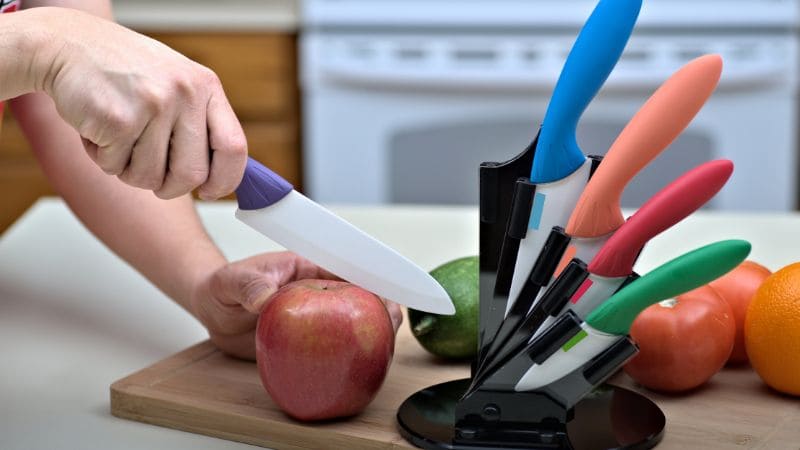
Cons of Ceramic Blades
While ceramic blades bring a lot to the table, they aren’t perfect. I learned this the hard way – literally – when I dropped my ceramic chef’s knife on the tile floor. The handle survived, but the blade? Not so much.
Ceramic knives have some limitations that are important to consider before investing in them. Let’s break down the key drawbacks.
Brittle and Prone to Chipping
Ceramic blades are incredibly hard, which helps them stay sharp longer. But that same hardness makes them brittle. One wrong move – like twisting the blade while cutting – can lead to chips or even cracks.
Ever tried to cut through a butternut squash with a ceramic knife? Don’t. I learned quickly that hard vegetables are better left to steel.
Key Points:
- Susceptible to chips if used on hard foods or bones.
- Dropping the blade can lead to irreversible damage.
- Prying or twisting can cause fractures along the blade.
Limited Versatility
Ceramic blades shine in precision tasks – slicing fruits, vegetables, and boneless meats. But when it comes to tougher jobs, they fall short. Forget about chopping frozen foods, carving through bone, or handling heavy-duty kitchen tasks.
Ceramic blades aren’t the multitasking heroes that steel knives are. I keep my ceramic knives for delicate jobs, but I rely on steel for the heavy lifting.
Not Suitable For:
- Cutting through bones.
- Frozen foods.
- Hard-skinned vegetables like pumpkin or squash.
Difficult to Sharpen
Sharpening a ceramic blade isn’t as simple as running it through a honing rod. Standard knife sharpeners won’t work – you’ll need a diamond stone or a professional service.
Trust me, I tried to sharpen mine with a regular steel sharpener once. Bad idea. The ceramic blade laughed at me and stayed dull.
Why It’s Challenging:
- Requires diamond sharpening tools.
- Can be costly to sharpen professionally.
- Improper sharpening may damage the blade further.
Higher Initial Cost
Quality ceramic knives often come with a higher price tag compared to steel knives. While they stay sharp longer, the upfront cost can be a deterrent.
I remember debating whether to splurge on a Kyocera chef’s knife – and while it was worth it in the long run, it definitely wasn’t cheap.
| Blade Type | Average Cost |
|---|---|
| Ceramic (High Quality) | $50 – $150+ |
| Stainless Steel | $20 – $70 |
| Carbon Steel | $30 – $100 |
Fragility When Dropped
This one hits home – literally. I dropped a ceramic paring knife onto my kitchen tiles, and it shattered like glass. If you’re clumsy like me, you might want to think twice about relying solely on ceramic.
The Reality:
- Ceramic knives are prone to shattering if dropped.
- Storage in protective sheaths or blocks is essential.
Pro Tip: Always store ceramic knives in a block or sheath to minimize the risk of accidental damage
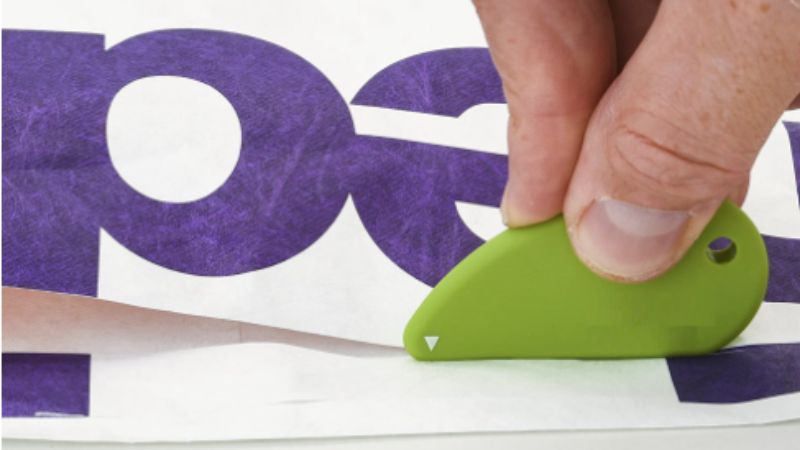
Comparison: Ceramic Blades vs. Steel Blades
Both ceramic and steel blades have their pros and cons, and when it comes to choosing between the two, it’s simply a case of apples versus oranges, because it’s always going to be about the kind of job you need doing. I’ve used both extensively in my kitchen and while ceramic blades can feel like a slick, futuristic upgrade, steel blades are still the stalwart workhorses of any cutting endeavor. Let’s take a closer look at how these two materials compare.
Durability and Strength
Steel blades, particularly high-carbon and stainless steel blades, are tough. They are flexible without breaking and cope well with heavy-duty tasks such as cutting through bone or frozen foods. Ceramic blades, however, are much harder — but also much more brittle. All it takes is one dropped knife and you chip and crack the blade.
Fact: Ceramic is approximately 8.5 on the Mohs scale of hardness, hardened steel is 5 to 7. This distinction is why ceramic blades retain their edge longer but are more delicate.
Sharpness Over Time
Ceramic blades are particularly good at maintaining their sharpness for a long time. A ceramic knife that is well-maintained can hold its edge for 10 times longer than the average steel blade. They are perfectly suited to tasks that require precision, such as delicate assembly tasks.
While sharp, steel knives need to be honed and sharpened often. However, they are easier to sharpen at home, while ceramic knives usually require professional sharpening or diamond-coated tools.
Maintenance Requirements
One of the reasons I enjoy ceramic blades is the low maintenance. I rinse them off, hang them to dry, and they stay rust-free.” Steel knives? Not so much. Steel blades can develop rust spots without regular oiling and drying — even if you leave them out in the sink to dry overnight.
Tip: If low-maintenance matters to you, ceramic blades are a no-brainer. But if you want a knife that can take a bit more routine abuse, it’s easier to go with steel.
Application Suitability
Ceramic knives are also great for slicing fruits, vegetables, and boneless meats. But for the tougher jobs — frozen foods or heavy-duty butchering, for example — steel blades win every time.
| Feature | Ceramic Blades | Steel Blades |
|---|---|---|
| Sharpness Retention | Stays sharp up to 10x longer | Dulls faster, needs regular honing |
| Durability | Brittle – Prone to chipping or breaking | Flexible – Resists bending and chipping |
| Rust Resistance | 100% Rust-Proof | Prone to rust without oiling |
| Maintenance | Low – Simple washing | High – Requires oiling, honing |
| Versatility | Soft foods, fruits, boneless meats | Handles bones, frozen foods, heavy-duty |
| Sharpening | Requires diamond tools or professional service | Easily sharpened at home |
| Weight | Lightweight | Heavier |
| Cost | Higher upfront cost | Affordable options available |
Authoritative Reference
For more information on knife materials and blade longevity, check out America’s Test Kitchen, which frequently reviews and compares different types of knives for kitchen use.
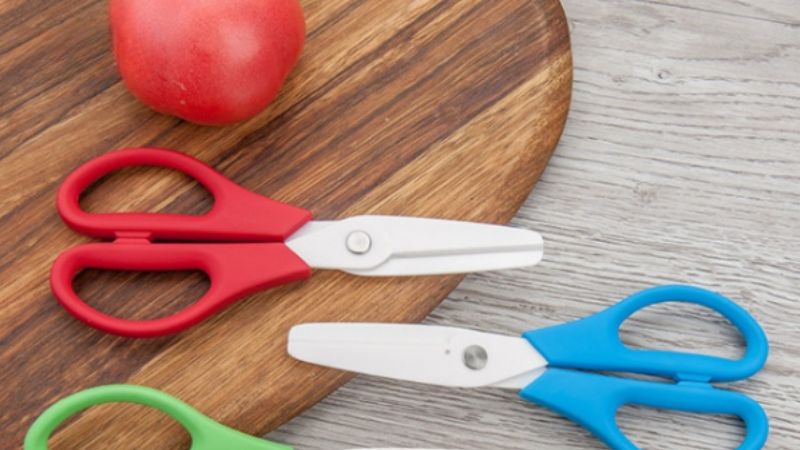
Best Uses for Ceramic Blades
I learned the hard way that ceramic blades aren’t for everything. The first time I tried cutting into a chicken with my brand-new ceramic chef’s knife, I heard a snap – and suddenly I had two knives, one in each hand. Since then, I’ve discovered where ceramic blades truly shine, and trust me, they can be game-changers for the right tasks.
Precision Cutting – Fruits, Vegetables, and Boneless Meats
Ceramic blades are at their best when precision is required. Their razor-sharp edges make quick work of soft foods like tomatoes, cucumbers, and herbs, where a dull knife might crush instead of slice. I use mine for slicing strawberries or dicing onions – the results are perfect every time.
Key Foods for Ceramic Knives:
- Soft fruits – Tomatoes, kiwis, mangoes
- Vegetables – Bell peppers, zucchinis, leafy greens
- Boneless meats – Chicken breasts, fillets, and deli meats
Pro Tip: Ceramic knives are excellent for sushi preparation or any dish that requires delicate, thin slicing.
Everyday Kitchen Tasks
If you’re not chopping through bones or frozen foods, a ceramic knife can handle most daily kitchen prep tasks. I use mine for salad prep, cutting sandwich ingredients, and trimming herbs straight from the garden.
Perfect for:
- Slicing bread (without a hard crust)
- Cutting cheeses (soft to medium)
- Chopping cooked meats for salads and sandwiches
Professional Presentation – Ultra-Thin Slices
Ever wonder how restaurants get those paper-thin radish slices for garnish? A ceramic blade is the secret. The ultra-sharp edge allows for precise, uniform cuts, perfect for plating and decoration.
Ideal for:
- Fine slicing of garnishes – radishes, carrots, cucumbers
- Carving delicate fruit displays
Hygiene-Focused Environments
One of the best parts about ceramic knives is their non-porous surface. This means they won’t absorb food particles or odors. In professional kitchens, this translates to cleaner, more hygienic cuts – no lingering garlic smell on your next batch of apples.
Best for:
- Cutting fish or meats where cross-contamination is a concern
- Preparing foods with strong odors (garlic, onions, ginger)
Industrial and Craft Applications
Ceramic blades aren’t limited to the kitchen. Their precision and durability make them valuable in industrial settings as well. From cutting textiles to detailed craft work, ceramic blades are trusted tools in various trades.
Common Non-Kitchen Uses:
- Textile and fabric cutting
- Crafting – Paper, foam, and leather trimming
- Medical applications – Precision cutting in laboratories
| Use Case | Ceramic Blade Effectiveness |
|---|---|
| Soft Fruits and Vegetables | ★★★★★ – Exceptional |
| Boneless Meats | ★★★★★ – Highly Effective |
| Frozen Foods | ★☆☆☆☆ – Not Recommended |
| Bone Cutting | ★☆☆☆☆ – Avoid |
| Bread (Soft Crust) | ★★★★☆ – Good |
| Crafting/Industrial | ★★★★★ – Excellent |
Ceramic blades might not replace every knife in your kitchen, but for the right tasks, they outperform traditional steel in ways that truly make a difference.
How to Care for Ceramic Blades
Caring for ceramic blades doesn’t require much effort – but trust me, a little care goes a long way in keeping them sharp and chip-free. I learned this after cracking my first ceramic knife by casually tossing it into a drawer. Lesson learned.
Here’s how to properly maintain ceramic blades so they stay sharp and last for years.
Proper Cleaning Methods
Ceramic blades are non-porous, which means they don’t absorb food particles or odors. This makes cleaning them simple and fast. However, while they resist stains, improper cleaning can still lead to chips.
Cleaning Tips:
- Hand Wash Only – Avoid dishwashers. The harsh cycles and clinking with other utensils can cause chips or cracks.
- Use Mild Soap and Warm Water – A gentle hand wash with a soft sponge is all you need.
- Avoid Abrasives – Scouring pads and abrasive cleaners can wear down the blade’s surface. Stick to soft materials.
Pro Tip: Rinse the blade immediately after cutting acidic foods like lemons or tomatoes to prevent residue buildup.
Safe Storage Practices
How you store ceramic knives makes a huge difference. Since they’re prone to chipping, leaving them in a crowded drawer (like I did) is asking for trouble.
Best Storage Options:
- Knife Blocks or Sheaths – Protects the blade from accidental contact with other utensils.
- Magnetic Strips – Great for keeping knives accessible, but choose one designed for ceramic blades to avoid strong pulls that can crack the blade.
- Drawer Organizers – If you must store them in a drawer, use dividers to prevent the blade from touching other objects.
| Storage Option | Protection Level | Ease of Access |
|---|---|---|
| Knife Block | ★★★★★ | ★★★☆☆ |
| Protective Sheath | ★★★★★ | ★★★★☆ |
| Magnetic Strip | ★★★★☆ | ★★★★★ |
| Drawer Organizer | ★★★☆☆ | ★★★☆☆ |
Preventing Chipping and Breakage
Ceramic blades excel in slicing, but they’re not built for forceful tasks. I once tried cutting a frozen pizza – big mistake. Ceramic blades don’t bend like steel, which means applying too much pressure can snap the blade.
Avoid These Common Mistakes:
- No Bones or Frozen Foods – Stick to soft produce and boneless meats.
- No Twisting or Prying – Use ceramic blades for straight cuts only. Twisting the blade can cause fractures.
- Cutting Surfaces Matter – Use wooden or plastic cutting boards. Glass or marble boards can damage the blade’s edge.
Pro Tip: Treat ceramic knives like specialty tools – they’re perfect for delicate slicing but not for heavy-duty chopping.
Occasional Sharpening
While ceramic blades stay sharp for a long time, they do eventually dull. Sharpening them isn’t as simple as using a steel honing rod. You’ll need specialized tools or professional services.
Sharpening Options:
- Diamond Sharpening Stones – The only effective material for sharpening ceramic.
- Professional Services – If you’re unsure, let the experts handle it. Many knife brands offer mail-in sharpening services.
- Electric Sharpeners (Designed for Ceramics) – Some models are equipped with diamond-coated wheels suitable for ceramic knives.
| Sharpening Method | Effectiveness | Cost |
|---|---|---|
| Diamond Stone | ★★★★★ | $$ |
| Professional Service | ★★★★★ | $$$ |
| Electric Sharpener | ★★★★☆ | $$$ |
| Standard Steel Sharpener | ★☆☆☆☆ | Incompatible |
Transport and Travel Tips
If you’re bringing a ceramic blade on the go – say, for a picnic or camping trip – extra care is required. A simple bump can cause damage.
Travel Tips:
- Always use a sheath or blade guard.
- Wrap the knife in a soft cloth if a sheath isn’t available.
- Avoid keeping the blade in contact with metal utensils during transport.
By following these care tips, you’ll keep your ceramic knives in top shape for years. They may require a bit of caution, but the precision and low maintenance make them a valuable addition to any kitchen.
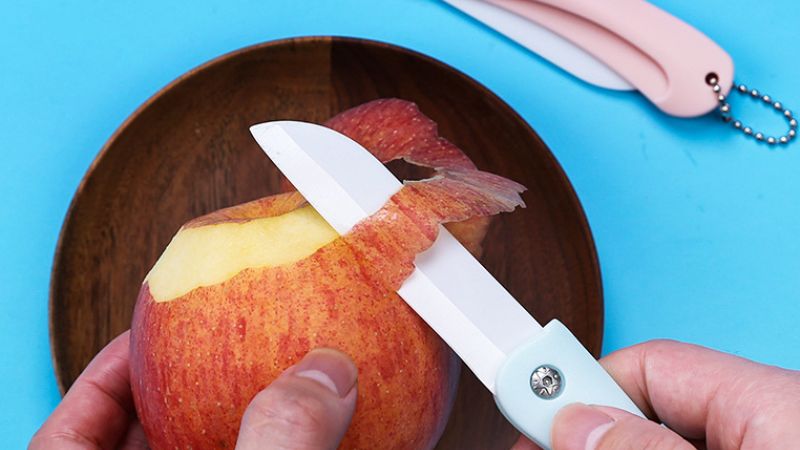
FAQ About Ceramic Blades
Are ceramic blades better than steel blades?
It depends on the task. Ceramic blades are sharper and hold their edge longer than steel blades, making them ideal for slicing soft foods and precise cuts. But they’re also more brittle and can chip easily, so it’s better to use steel blades for heavy-duty cutting, bones or frozen foods.
Can ceramic knives slice bone or frozen foods?
No. Ceramic knives are not designed to cut through bones or frozen items. Doing so can chip or crack the blade. For good results throughout, limit diet to soft foods, fruits, vegetables, and boneless meats.
How long do ceramic blades stay sharp?
Ceramic blades can remain sharp for 10 times as long as steel blades. If looked after properly, they’ll keep their edge for months or even years before a sharpening is needed — again, depending on how they are being used.
What not to do with ceramic knives?
Avoid using ceramic knives for:
- Chopping hard foods or bones
- Twisting or prying
- Cutting on glass, marble, or stone surfaces
- Dropping or throwing them – they can shatter easily.
Conclusion
Ceramic blades offer unmatched sharpness, rust resistance, and ease of use, making them perfect for light kitchen tasks. However, their brittleness and limited versatility can’t be ignored. If precision slicing is a priority, they’re a solid choice – but for heavy-duty cutting, steel blades may still be the better bet.
